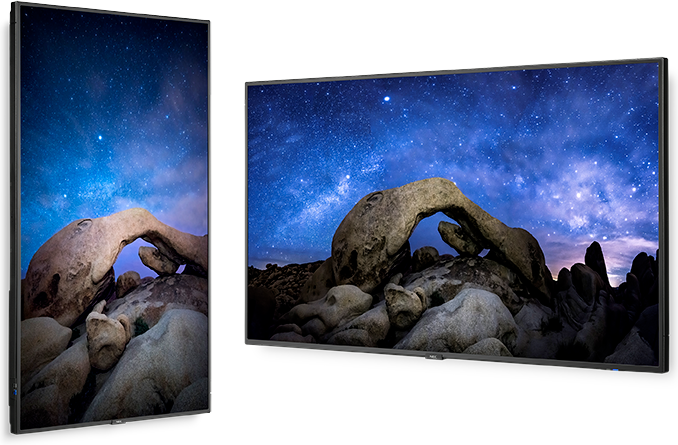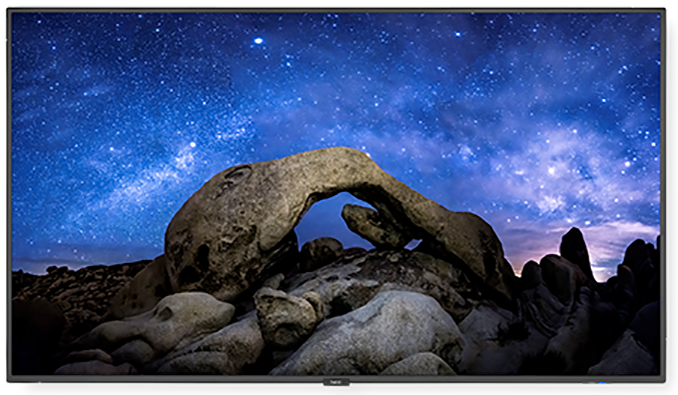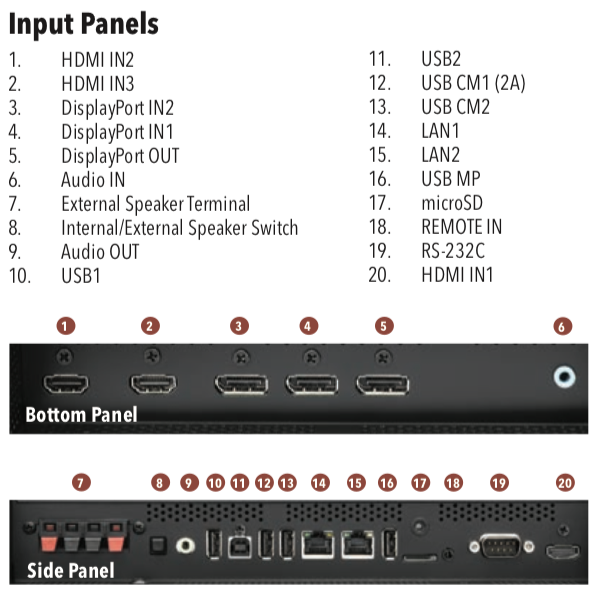NEC Launches V554Q: A 55-Inch 4K Monitor for Professional & Signage Applications
by Anton Shilov on March 26, 2019 6:15 PM EST
NEC has introduced its new large-format 55-inch 4K display designed for commercial and digital signage applications, the NEC MultiSync V554Q.
The V554Q display is based on an IPS panel featuring a 3840×2160 resolution, 500 nits max brightness, a 1100:1 contrast ratio (without local dimming), a 60 Hz refresh rate, a 8 ms response time, 178º viewing angles, and so on. The LCD can display ‘more than’ 1.07 billion colors and, still uncommon for most monitors, supports the BT.2020 color space (though the manufacturer doesn't list how much of the gamut is supported).
One of the key features of the V554Q monitor is its anti-glare coating, which the manufacturer says can removes glares almost completely without compromising color accuracy. Another key technology used on the monitor is NEC’s SpectraView Engine, the company’s proprietary color management and color uniformity correction tool. Finally, to ensure longevity of the display even if it has to work in tough conditions for 24/7, it features an integrated cooling system with three fans, which kicks off automatically when internal sensors detect high temperatures.
Since the NEC V554Q was formally designed primarily for digital signage, the monitor has an on-board media player that can playback content from an SD card or a USB drive. It also has an OPS slot for NEC’s Raspberry Pi compute module, essentially allowing to installa fully-fledged PC inside the display. Meanwhile, the LCD can be controlled using local buttons, an IR remote, as well as remotely using 100 Mbps Ethernet ports, or an RS232 connector (as well as NEC’s NaViSet Administrator software).
Speaking of connectivity, it is necessary to note that the MultiSync V554Q has two DisplayPort 1.2, three HDMI 2.0 inputs, and various audio outputs (3.5 mm, HDMI out, analog, DP Audio out).
| NEC's 55-Inch UHD Display | ||
| MultiSync V554Q | ||
| Panel | 55" IPS | |
| Native Resolution | 3840×2160 | |
| Maximum Refresh Rate | 60 Hz | |
| Response Time | 8 ms | |
| Brightness | 500 cd/m² | |
| Contrast | 1100:1 | |
| Viewing Angles | 178°/178° horizontal/vertical | |
| Pixel Pitch | 0.3171 mm2 | |
| Pixel Density | 80 ppi | |
| Color Gamut | 1.07 billion+ | |
| Inputs | 2 × DisplayPort 1.2 3 × HDMI 2.0 RS-232C |
|
| Outputs | 3.5 mm audio output DisplayPort Audio HDMI Audio |
|
| USB/MicroSD | 4 × USB Type-A ports MicroSD slot |
|
| LAN | 2 × 10 Mbps Ethernet | |
| Power Consumption (idle/active) | Idle: 0.5 W Typical: 120 W Max: 300 W |
|
| Launch Price | $1,849 | |
Besides the compute module, NEC offers numerous accessories for its 55-inch V554Q monitor, including a tabletop stand, external speakers, human sensor, wall mount, and so on. Which means that while the monitor may be first and foremost aimed at digital signage, it is a complete stand-alone (and standing) monitor that can be used for more regular workloads as well.
NEC’s MultiSync V554Q can be ordered from NEC and its partners for $1,849. In addition, the manufacturer offers the V554Q-AVT2 model with an integrated ATSC tuner.
Related Reading:
- NEC Launches Narrow Bezel MultiSync EA271U Display: 4K & USB-C Charging
- NEC Goes for a Curved Display, Launches 3440×1440 MultiSync EX341R Monitors
- BenQ Unveils PD3220U Professional Monitor with AQColor, TB3, HDR10, & KVM
- Philips Brilliance 499P9H Ultra-Wide 49-Inch Monitor Now Available
- NVIDIA’s 65-inch Big Format Gaming Display Is Here: HP OMEN X Emperium
Source: NEC












34 Comments
View All Comments
Duncan Macdonald - Tuesday, March 26, 2019 - link
This looks far better value than the ASUS PQ22UC monitor featured a few days ago.Death666Angel - Tuesday, March 26, 2019 - link
Because people interested in 22" 4K OLED displays and people interested in 55" 4K LCD displays with a ton of inputs and outputs are basically looking for the same thing.zodiacfml - Tuesday, March 26, 2019 - link
Point is, ASUS could have taken a OLED TV panel from LG than a limited volume 22 inch OLED screen.However, this product is intriguing. These signage displays, most, if not all, are simply TVs from known brands. I guess this is to sell to organizations that exclusively buy NEC products.
Kakti - Tuesday, March 26, 2019 - link
smh...ASUS has a whole line of commercial signage monitors from 42" to at least 55".Check out https://www.asus.com/Commercial-Signage/AllProduct...
T
Kakti - Tuesday, March 26, 2019 - link
The cheap ones are used for fast food restaurant menus, airports and other places where picture quality isn't that important.The high end ones like this are likely used for corporate video conference rooms like the ones in my office. Or I can see them being used at design firms to show a large scale display of whatever they're working on (advertising/commercials, photography/video/animation studios, game development, etc.). Colleges and medical establishments are switching to high end monitors. There's a time and place for high end 22" 4k OLED screens (MRI technician looking at a scan) and then there's a time and place for a high end 55" OLED screen (same MRI tech showing results to the patient).
Hubb1e - Thursday, March 28, 2019 - link
There are special medical grade displays that focus on grayscale in order to ensure that you can see all of the gradients in the scan.lilkwarrior - Friday, March 29, 2019 - link
Those medical grade displays are significantly ideally OLED monitors.Kevin G - Friday, March 29, 2019 - link
OLED is being looked at but right now no vendor has adopted them due to burn in issues.Barcos are exceptional displays but they leverage their own special panels and their latest is a 4200 x 2800 custom setup fed by dual DP 1.2 cables. Maximum brightness is 2000 nits which I wholely believe after using several in person. The reason for their insane brightness is that they expect doctors to put Xrays up against the display and they need the extra light to shine through the film.
Death666Angel - Wednesday, March 27, 2019 - link
And Maserati could have taken the engine and chassis from a Volkswagen Beetle and offered a 30k car instead of a 300k one. Your point does not make any sense.Valantar - Wednesday, March 27, 2019 - link
More than likely these panels don't fulfill their requirements for gamut, color accuracy, sharpness, pixel pitch, contrast, uniformity, or any other of the host of criteria that need to be nigh-on perfect for a video production-grade monitor. And the cost of a controller capable of handling a 14-bit LUT in real-time without adding noticeable latency. Not to mention the added difficulty of producing all of this on a much smaller scale, and the dramatically increased degree of quality control in pro monitors compared to TVs.